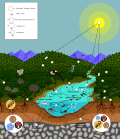The competitive Lotka–Volterra equations are a simple model of the population dynamics of species competing for some common resource. They can be further...
21 KB (3,114 words) - 15:07, 27 August 2024
The Lotka–Volterra equations, also known as the Lotka–Volterra predator–prey model, are a pair of first-order nonlinear differential equations, frequently...
34 KB (4,490 words) - 10:11, 9 May 2025
generalized Lotka–Volterra equations are a set of equations which are more general than either the competitive or predator–prey examples of Lotka–Volterra types...
12 KB (1,821 words) - 15:07, 27 August 2024
The random generalized Lotka–Volterra model (rGLV) is an ecological model and random set of coupled ordinary differential equations where the parameters...
15 KB (2,056 words) - 22:22, 14 April 2025
have been formalized in a mathematical model called the Competitive Lotka–Volterra equations, which creates a theoretical prediction of interactions....
25 KB (3,337 words) - 15:20, 12 May 2025
Population model (section Equations)
growth equation: d N d t = r N ( 1 − N K ) {\displaystyle {\frac {dN}{dt}}=rN\left(1-{\frac {N}{K}}\right)\,} Competitive Lotka–Volterra equations: d N...
6 KB (734 words) - 06:29, 7 February 2025
nearly untestable in reality. Competitive exclusion principle Competitive Lotka–Volterra equations Lotka–Volterra equation Gause, GF. 1932. Experimental...
10 KB (1,450 words) - 16:15, 1 June 2024
presence of one aids the population growth of the other. See Competitive Lotka–Volterra equations for further extensions of this model. Unified neutral theory...
61 KB (7,435 words) - 15:18, 12 May 2025
Consumer-resource model (category Ordinary differential equations)
generalized Lotka–Volterra model. Theoretical ecology Community (ecology) Competition (biology) Lotka–Volterra equations Competitive Lotka–Volterra equations Generalized...
27 KB (4,412 words) - 13:38, 11 April 2025
independently by Alfred J. Lotka in 1925 and Vito Volterra in 1926. An extension to these are the competitive Lotka–Volterra equations, which provide a simple...
34 KB (4,251 words) - 16:41, 26 April 2024
evolutionist and the microbiologist in one personality. Competitive Lotka–Volterra equations Brazhnikova, MG. 1987. Obituary. The Journal of Antibiotics...
8 KB (1,098 words) - 04:02, 1 November 2024
ecological factors are constant. Competitive exclusion is predicted by mathematical and theoretical models such as the Lotka–Volterra models of competition. However...
23 KB (2,736 words) - 20:32, 12 May 2025
trophic interactions to biogeochemistry. The model is related to the Lotka–Volterra equations. It assumes that prokaryotes adopt one of two strategies when competing...
23 KB (2,553 words) - 21:49, 9 February 2024
This is a list of scientific equations named after people (eponymous equations). Contents A B C D E F G H I J K L M N O P R S T V W Y Z See also References...
30 KB (438 words) - 21:15, 3 October 2024
who live in similar areas typically compete with each other. The Lotka–Volterra equation states that two competing species can coexist when intra-specific...
70 KB (8,391 words) - 17:25, 8 April 2025
between species in competition (e.g. where αij parameters in Lotka-Volterra competition equations are non-zero). Frequency-dependent selection can also lead...
12 KB (1,355 words) - 11:26, 18 February 2025
them. Male elephant seals, Mirounga augustirostris, engage in fierce competitive displays in an attempt to control a large harem of females with which...
23 KB (2,707 words) - 02:21, 17 March 2024
Dianna K. (July 24, 1984). "The importance of form: Differences in competitive ability, resistance to consumers and environmental stress in an assemblage...
26 KB (2,791 words) - 11:07, 9 April 2025
approximation Gillespie algorithm Balance equation Belousov–Zhabotinsky reaction Lotka–Volterra equations Chemical kinetics Gold, Victor, ed. (2019)...
44 KB (7,579 words) - 10:54, 14 May 2025
hybrids appear to have higher fitness than native iguanas, leading to competitive outcompetition and replacement. Numerous populations have already become...
50 KB (5,511 words) - 06:15, 14 May 2025
suffers from being crushed. Amensalism also includes strongly asymmetrical competitive interactions, such as has been observed between the Spanish ibex and...
32 KB (3,387 words) - 08:39, 18 April 2025
of larger males. When smaller males got larger, and their calls more competitive, then they started calling and competing directly for mates. In many...
110 KB (14,230 words) - 09:03, 18 April 2025
pattern. For instance, trees have traits such as longevity and strong competitiveness that characterise them as K-strategists. In reproduction, however,...
30 KB (3,200 words) - 04:38, 26 March 2025
can form cycles, which are usually mathematically modelled as Lotka–Volterra equations. In natural ecosystems, predator population growth lags just behind...
59 KB (7,040 words) - 23:57, 11 February 2025
gain for the invader is a loss for the native. However, such unilateral competitive superiority (and extinction of native species with increased populations...
131 KB (13,466 words) - 10:46, 8 May 2025
cycle' was replaced by 'food web' in a subsequent ecological text. Alfred J. Lotka brought in many theoretical concepts applying thermodynamic principles to...
210 KB (21,621 words) - 14:42, 14 April 2025
two species. Abiotic factors such as salinity can give one species a competitive advantage over another, creating pressures that lead to speciation and...
6 KB (660 words) - 17:21, 22 October 2024
Predator–prey (Lotka–Volterra) equations Recruitment Small population size Stability Resilience Resistance Random generalized Lotka–Volterra model Species...
23 KB (2,390 words) - 03:22, 17 March 2025
succession proceeds, these species will tend to be replaced by more competitive (k-selected) species. Some of these trends do not apply in all cases...
56 KB (6,726 words) - 03:42, 11 May 2025
declines. Due to lack of predation the prey population increases. See Lotka–Volterra equations for more details on this. A well-known example of this is lynx-hare...
46 KB (5,379 words) - 15:01, 31 December 2024


















